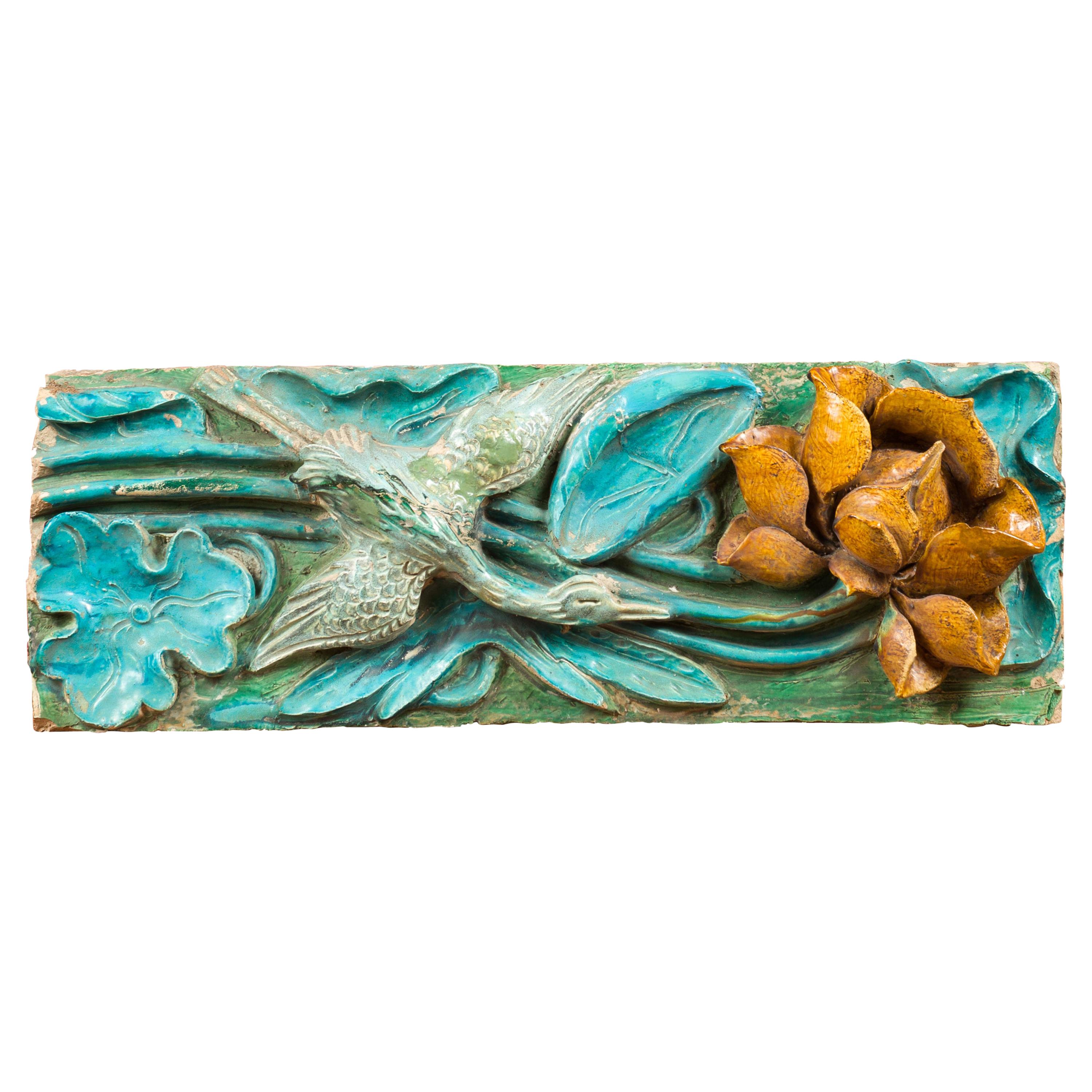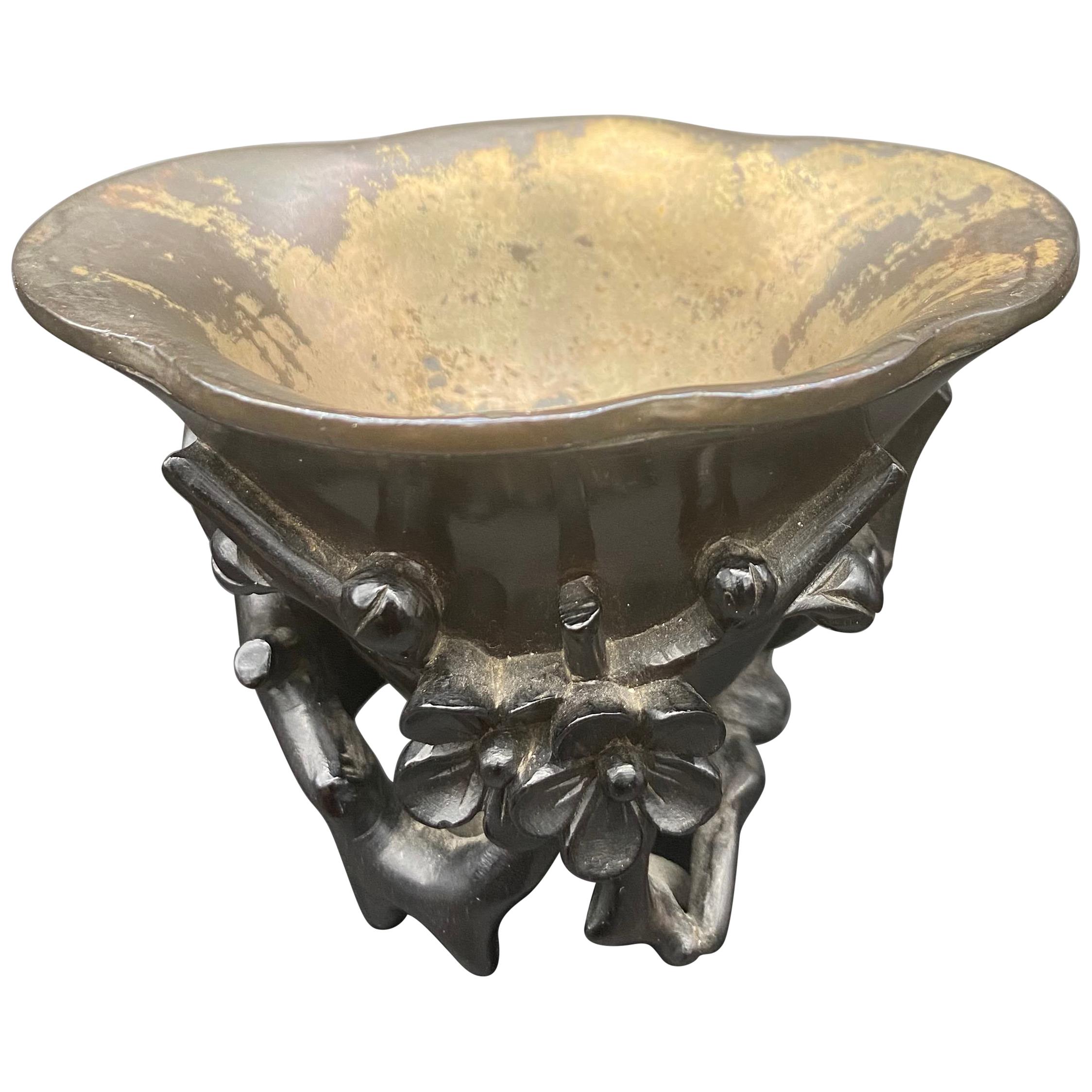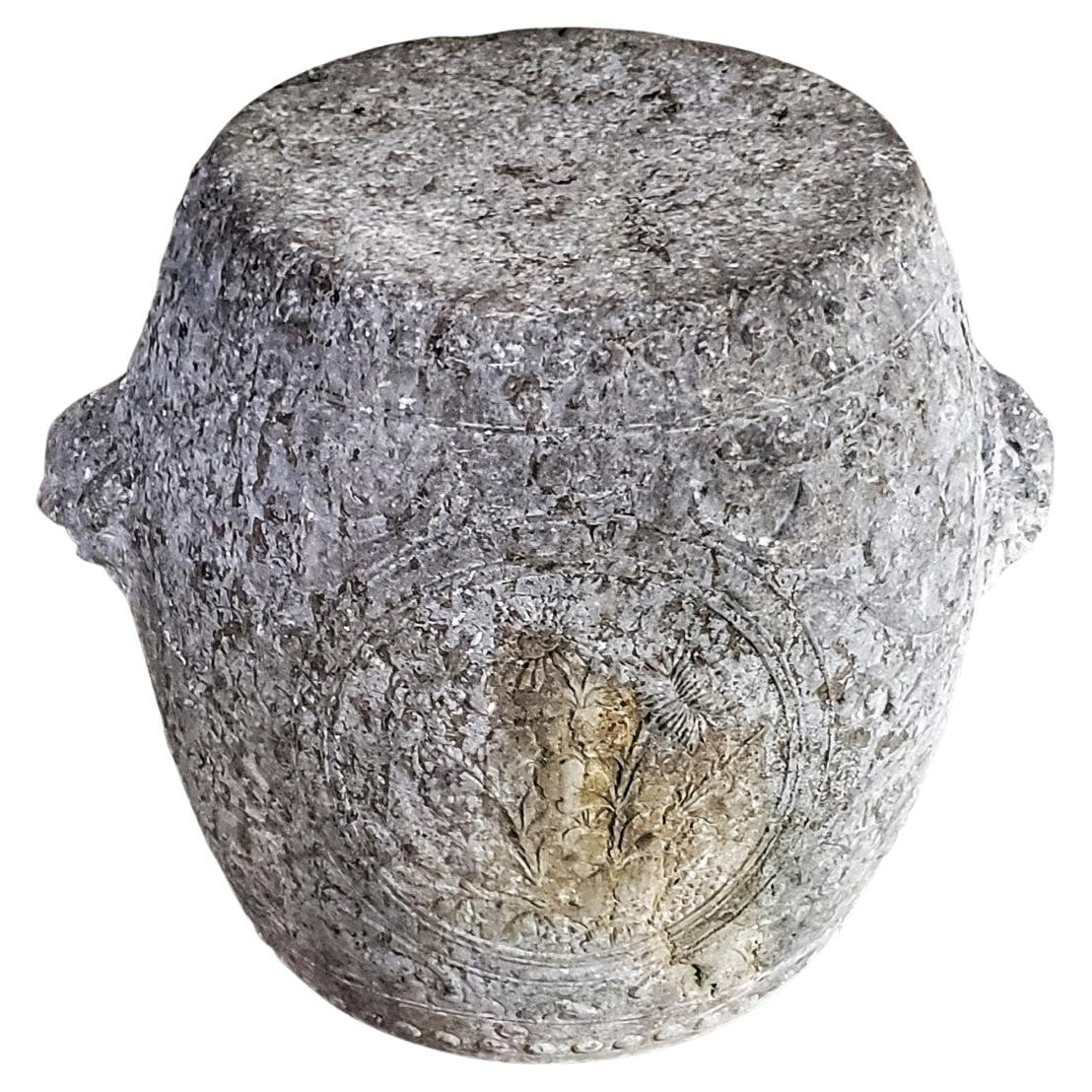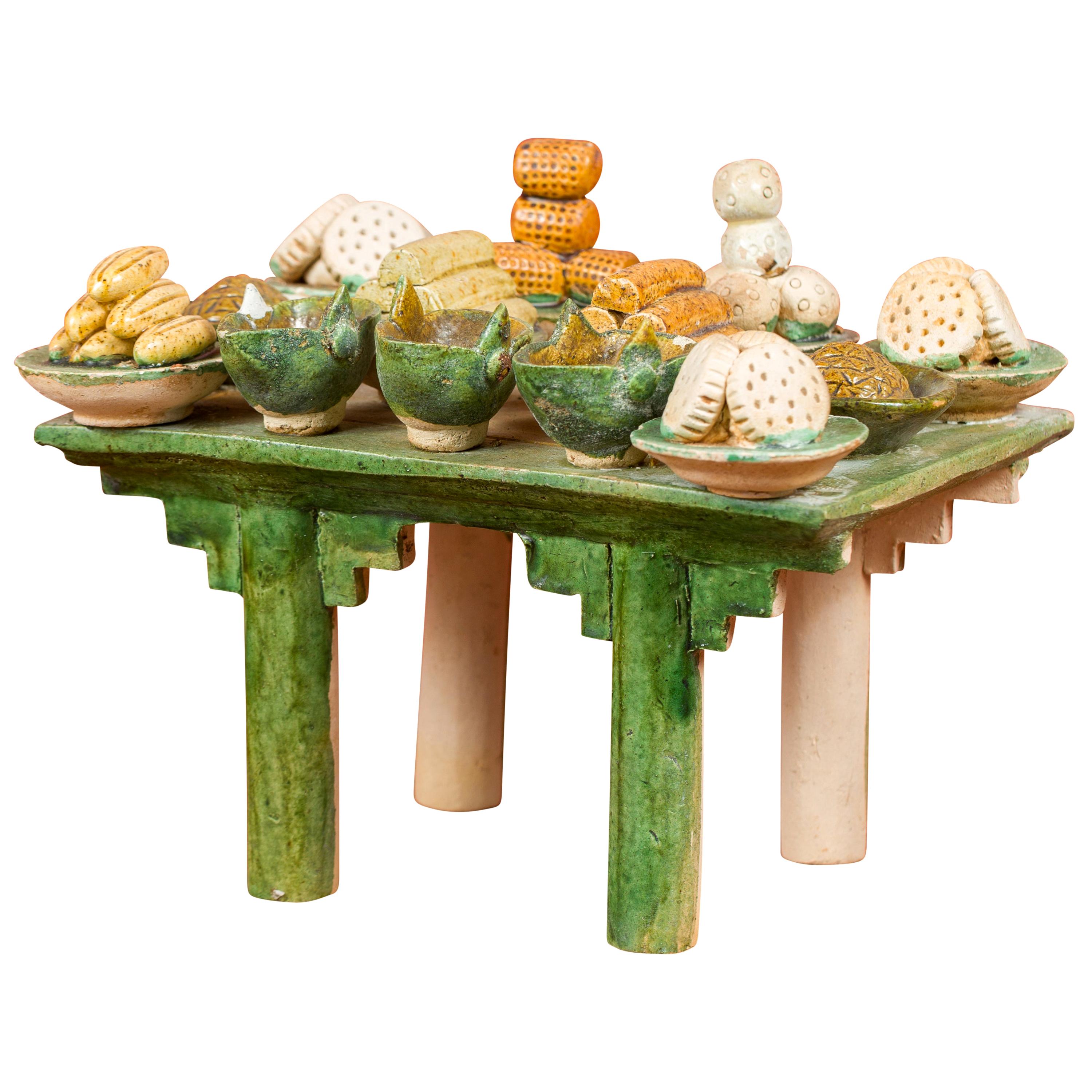Items Similar to Chinese Ming Dynasty 17th Century Three-Color Glazed Terracotta Temple Roof Tile
Want more images or videos?
Request additional images or videos from the seller
1 of 13
Chinese Ming Dynasty 17th Century Three-Color Glazed Terracotta Temple Roof Tile
About the Item
A Chinese Ming Dynasty period temple roof tile from the 17th century, with turquoise finish, bird and flower. Created in China during the Ming Dynasty (1368-1644), this ancient temple roof tile was made from molded terracotta and painted. Showcasing a bird flying down to reach a beautiful flower, the plaque is painted in the Sancai, or “Three-colors” technique with green, blue and orange glazes, a technique popularized during the 8th century Tang Dynasty. A great decorative choice to highlight any home decor!
- Dimensions:Height: 11 in (27.94 cm)Width: 23.5 in (59.69 cm)Depth: 4.5 in (11.43 cm)
- Style:Ming (Of the Period)
- Materials and Techniques:
- Place of Origin:
- Period:
- Date of Manufacture:17th Century
- Condition:Wear consistent with age and use. Please refer to the various additional photos for further condition detail and contact us with any questions!
- Seller Location:Yonkers, NY
- Reference Number:
About the Seller
5.0
Platinum Seller
These expertly vetted sellers are 1stDibs' most experienced sellers and are rated highest by our customers.
Established in 1968
1stDibs seller since 2009
915 sales on 1stDibs
Typical response time: <1 hour
- ShippingRetrieving quote...Ships From: Yonkers, NY
- Return PolicyA return for this item may be initiated within 3 days of delivery.
More From This SellerView All
- Chinese Ming Dynasty 17th Century Glazed Terracotta Sancai Temple Roof TileLocated in Yonkers, NYA Chinese Ming Dynasty period temple roof tile from the 17th century, with turquoise glaze, bird and flower motifs. Created in China during the Ming Dynasty which ruled from 1368 to ...Category
Antique 17th Century Chinese Ming Antiquities
MaterialsTerracotta
- Chinese Ming Dynasty Period Ancient Turquoise Roof Tile with Crane and FlowerLocated in Yonkers, NYA Chinese Ming Dynasty period ancient roof tile with turquoise finish, crane and flower. Created in China during the Ming Dynasty (1368-1644), this ancient roof tile features a turqu...Category
Antique 15th Century and Earlier Chinese Ming Antiquities
MaterialsCeramic
- Chinese Ming Dynasty 15th or 16th Century Glazed Terracotta Funeral Table MingqiLocated in Yonkers, NYA Chinese Ming dynasty period glazed terracotta funeral table mingqi from 15th-16th century with food and drinks. Created in China during the Ming Dynasty, this terracotta funeral table showcases a typical Chinese altar, painted in green with tempera and adorned with a lovely variety of modeled and painted miniature food and drinks such as cakes. Called Mingqi, these kinds of terracotta models were traditionally placed in Chinese burials...Category
Antique 16th Century Chinese Ming Antiquities
MaterialsTerracotta
- Ming Dynasty 15th or 16th Century Chinese Glazed Terracotta Funeral Table MingqiLocated in Yonkers, NYA Chinese Ming dynasty period glazed terracotta funeral table mingqi from 15th-16th century with food in dishes. Created in China during the Ming Dynasty, this terracotta funeral table showcases a typical Chinese altar, painted in green with tempera and adorned with a lovely variety of modeled and painted miniature foods such as cakes and breads. Called Mingqi, these kinds of terracotta models were traditionally placed in Chinese burials...Category
Antique 16th Century Chinese Ming Antiquities
MaterialsTerracotta
- Chinese Ming Dynasty Period Ancient Turquoise Roof Tile with Crane and FlowerLocated in Yonkers, NYA Chinese Ming dynasty period ancient roof tile with turquoise finish, crane and flower. Created in China during the Ming dynasty (1368-1644), this ancient roof tile features a turqu...Category
Antique 16th Century Chinese Ming Antiquities
MaterialsCeramic
- Chinese Qing Dynasty Glazed Terracotta Sancai Temple Roof Tile, Raised ReliefLocated in Yonkers, NYA Chinese Qing Dynasty period glazed terracotta turquoise Sancai temple roof tile with raised relief and flower motif. This exquisite Qing Dynasty period Sancai roof tile...Category
Antique 19th Century Chinese Qing Ceramics
MaterialsTerracotta
You May Also Like
- 17th Century Ming Dynasty Chinese Zitan Libation Cup Silver InlaidLocated in Brea, CA17th century Ming dynasty Chinese Zitan libation cup silver inlaid, of deep oval form , the exterior carved in high relief and undercut around the sides and base with gnarled branche...Category
Antique Early 17th Century Chinese Ming Antiquities
MaterialsWood
- 17th Century Ming Dynasty Carved Stone Barrel #01Located in Chicago, IL17th Century Ming Dynasty carved marble garden seat with Foo Dog handles, floral reliefs and bat wing decoration. The Chinese symbol for bat and fo...Category
Antique 17th Century Chinese Ming Antiquities
MaterialsMarble
- 17th Century Pair of Ming Dynasty Chinese ZiTan Inlaid Silver CupsLocated in Brea, CA17th century a pair of Ming dynasty Chinese ZiTan inlaid silver cups, the exterior carved in high relief and undercut around the sides and base with Chi dragon, 5 edges with silver l...Category
Antique Early 17th Century Chinese Ming Antiquities
MaterialsWood
- 6 Elegant Ming Dynasty Court Attendants in Glazed Terracotta, China 1368-1644 ADLocated in San Pedro Garza Garcia, Nuevo LeonA fine set of a six court attendants as in the Forbidden City of Beijing, elegantly dressed in a Green & Red Daopao – a traditional men’s formal attire from the Ming Dynasty dated 1368-1643 A.D. – with glazed robes and Red Pigment remains in their hat and belts. They stand in an honorary posture atop a red plinth, some with orifices in their hands, where spirit objects were placed to comfort or satisfy the deceased. The heads are detachable, as often seen on the larger figures from this period. They are accompanied by a Certificate of Authenticity, and Certificate of Expertise by Jean-Yves Nathan - a leading authority specialized in Far East Archaeology from the CEDEA (The European Confederation of Art Experts). Burial figurines of graceful dancers, mystical beasts, and everyday objects reveal both how people in early China approached death and how they lived. Since people viewed the afterlife as an extension of worldly life, these figurines, called mingqi, sometimes referred as “spirit utensils” or “vessels of ghosts” disclose details of routine existence and provide insights into belief systems over a thousand-year period. The Ming dynasty was the ruling dynasty of China – then known as the Empire of the Great Ming – for 276 years (1368–1644 AD). Founded by Chu Yuan-chang, the rebel leader that was successful in removing the mongols from the throne. Chinese control was re-asserted in China and eastern Asia. Literature became more important, schools were created, and the justice system was reformed. The Ming dynasty is described by some as "one of the greatest eras of orderly government and social stability in human history,” was the last imperial dynasty in China ruled by ethnic Han Chinese. The practice of burying ceramic objects with the deceased went into decline from the 10th to the 14th Century AD. There was a revival in placing miniature representations of glazed terracotta objects such a furniture, food offerings, horses, miniature statues...Category
Antique 15th Century and Earlier Chinese Ming Antiquities
MaterialsTerracotta
- 17th Century Ming Dynasty Carved Stone Barrel #02 (Pair or Individually)Located in Chicago, IL- Sold individually or as a pair - 17th Century Ming Dynasty carved stone barrel, with Foo Dog handles, floral reliefs and bat wing decoration. The Chinese symbol for bat and for go...Category
Antique 17th Century Chinese Ming Antiquities
MaterialsMarble
- Impressive Terracotta Funerary Procession - Ming Dynasty, China '1368-1644 AD'Located in San Pedro Garza Garcia, Nuevo LeonImpressive Funeral Ensamble of 10 Terracotta Glazed Figures in green and caramel colors depicting a votive procession with a palanquin, his four carriers, a horse, a stableman, two musicians, and an offering carrier. This ensemble is accompanied by a Certificate of Authenticity, and Certificate of Expertise by Jean-Yves Nathan - Specialist in Asian Arts for the CEDEA (The European Confederation of Art Experts). Burial figurines of graceful dancers, mystical beasts, and everyday objects reveal both how people in early China approached death and how they lived. Since people viewed the afterlife as an extension of worldly life, these figurines, called mingqi, sometimes referred as “spirit utensils” or “vessels of ghosts” disclose details of routine existence and provide insights into belief systems over a thousand-year period. The Ming dynasty was the ruling dynasty of China – then known as the Empire of the Great Ming – for 276 years (1368–1644 AD). Founded by Chu Yuan-chang, the rebel leader that was successful in removing the mongols from the throne. Chinese control was re-asserted in China and eastern Asia. Literature became more important, schools were created, and the justice system was reformed. The Ming dynasty is described by some as "one of the greatest eras of orderly government and social stability in human history,” was the last imperial dynasty in China ruled by ethnic Han Chinese. The practice of burying ceramic objects with the deceased went into decline from the 10th to the 14th Century AD. There was a revival in placing miniature representations of glazed terracotta objects such a furniture, food offerings, horses, miniature statues...Category
Antique 15th Century and Earlier Chinese Ming Antiquities
MaterialsTerracotta
Recently Viewed
View AllMore Ways To Browse
Antique Glaze Paint
Century Furniture Ming
The Ming
Chinese Ming
Glazed Tiles
Antique Blue Paint Color
Antique Blue Color Paint
Ancient Antiquities
Antique Chinese Ming
China 17th
17th Century China
Ming Dynasty
Antique Green Paint Color
Ming Dynasty China
Chinese Ming Dynasty
Chinese Temple
Chinese Ming Dynasty Furniture
Glazed Dynasty





